Ball Martin, M?ller Nicole. The Celtic Languages
Подождите немного. Документ загружается.


586 THE SOCIOLINGUISTICS OF THE CELTIC LANGUAGES
Watson, I. (2003) Broadcasting in Irish. Minority Language, Radio, Television and Identity, Dublin:
Four Courts Press.
—— (1997) ‘A history of Irish language broadcasting: national ideology, commercial interest and
minority rights’, in Kelly, M. and O’Connor, B. (eds) Media Audiences in Ireland, Dublin: UCD
Press, pp. 212–30.
Williams, N. (2006) Caighdeán Nua don Ghaeilge? An Aimsir Óg, Páipéar Ócaideach 1. Baile Átha
Cliath: Coiscéim.
CHAPTER 13
SCOTTISH GAELIC TODAY
Social history and contemporary status
Kenneth MacKinnon
GAELIC IN HISTORICAL PERSPECTIVE
Scotland’s linguistic history is complex. Its original inhabitants in early historical times
spoke a form of early Welsh – although what the northern Picts spoke is conjectural (Jack-
son 1955). The Gaelic language originally came to Scotland c.
AD 500 with the expansion
of the Northern Irish kingdom of Dál Riata into the western Highlands and Islands of
Scotland (Bannerman 1974). The expansion of this settlement, and the subsequent absorp-
tion of the Pictish kingdom in northern Scotland, the British kingdom of Strathclyde in
south- western Scotland, and part of Anglian Northumbria in the south- east, established a
largely Gaelic- speaking Scottish kingdom roughly conterminous with present- day Scot-
land by the eleventh century. Place- name evidence attests to this: names of Gaelic origin
are found throughout Scotland, and only in the Anglian south- east borders, and Norse
north- eastern Caithness and the Northern Isles, are they sparse (Nicolaisen 1976). Here
Norse settlement brought about the development of the Norn language, which lingered in
Shetland until the eighteenth century.
Celtic Christianity gained infl uence throughout this area from the coming of Columba
from Derry to Iona in 563, and this missionizing ‘Celtic’ Church fi rst brought literacy and
learning not only to the Gaelic Scots and their near neighbours but to much of England
also (Green 1911: 43–8). From the reign of Malcolm Canmore (1059–96), Gaelic lost its
pre- eminence fi rst at court; then among the aristocracy to Norman French infl uences; and
subsequently in the Lowlands, through the establishment of English- speaking burghs in
eastern and central Scotland, to English or Scots.
In the medieval period the British speech of Strathclyde was superseded fi rst by
Gaelic (Thomson 1968: 57), and subsequently by Scots, the West Germanic language
which developed from the Anglian speech of the Lothians. Language shift from Gaelic
to Scots proceeded across eastern Scotland and the western Lowlands, with Gaelic prob-
ably becoming extinct in south- western Scotland by the eighteenth century (Lorimer
1949–51).
By the seventeenth century Gaelic had retreated to the Highlands and Hebrides, which
still retained much of their political independence, Celtic culture and social structure. These
differences came to be seen as inimical to the interests of the Scottish and the subsequent
British state, and from the late fi fteenth century into the eighteenth a number of acts of
the Scottish and British parliaments aimed at promoting English- language education fi rst
among the aristocracy and subsequently among the general population; at outlawing the

588 THE SOCIOLINGUISTICS OF THE CELTIC LANGUAGES
native learned orders; and fi nally at disarming and breaking the clans and outlawing High-
land dress and music.
In the nineteenth century, contemporaneously with the notorious ‘Highland Clear-
ances’, which involved the enforced migration of the crofting population in many of the
Highland estates, a popular and successful voluntary Gaelic schools system came into
being. This was superseded after legislation in 1872 by a national English- medium school
system in which Gaelic had very little place. Some measure of security was given to the
crofting community by legislation in 1886. Despite the extension of the franchise and
the development of local government, recognition of Gaelic was initially very slow in
coming. Yet throughout the nineteenth century there had been vigorous calls for a place
for Gaelic in public life as well as in education. Withers (1988: 336) quotes a tract of 1828
seeking offi cial use of Gaelic in ‘the courts and other places of business’. Gaelic had a
central place in the religious life of the Highlands and in religious revivals. The language
was a political medium in the land agitation of the latter part of the nineteenth century, and
calls for its offi cial recognition were made in evidence to the Napier Commission inquiry
into the condition of the crofting community in 1883. A survey of Highland school boards
in 1876 revealed a ‘distinct majority in favour of including Gaelic in the curriculum’,
which met with some permissive response from the Scottish Education Board, but little
positive action by the Board or its inspectors (Smith 1983: 259–60).
From 1904 it was possible to take Gaelic as a ‘specifi c subject’, and the 1918 Edu-
cation Act provided for Gaelic to be taught ‘in Gaelic- speaking areas’, but these were
undefi ned and in practice very little was provided in terms of Gaelic education. However,
by the mid- twentieth century some instrumental acknowledgement of Gaelic had been
made by the Highland county education authorities, and from 1958 Gaelic began to be
used as an initial teaching medium in the early primary stages in Gaelic- speaking areas.
The language could be studied as an examination subject in parity with other languages at
the secondary stage. Since 1882 it had been possible to take Gaelic as part of a university
degree in Celtic. Some signifi cant developments in Gaelic education have occurred since
the mid- 1970s such as the bilingual education schemes in the Western Isles and Skye,
and the introduction of Gaelic as a second language at primary level. After its creation in
1975, the Western Isles authority, Comhairle nan Eilean, introduced a bilingual admin-
istrative policy, and bilingual schemes in primary education. However, in 1979 its nerve
failed and it did not extend this to the secondary stage. In other Scottish regions, such as
Highland and Strathclyde, bilingual primary education was making some headway in this
period, and from 1985 Gaelic- medium primary education was initated in two schools: at
Inverness and Glasgow. By 2008–9) these had increased to 60 schools with 2,206 pupils.
The neglect of Gaelic in the education system after 1872 resulted in the language sur-
viving as an oral rather than a literary medium for many of its speakers. The purpose of
school was to promote English literacy. Thus traditional Gaelic literacy was associated
with a religious culture which emphasized Bible reading, home worship and the singing
of the Metrical Psalms. Calvinism has promoted Gaelic literacy, and in the strongholds of
the Free Church and Free Presbyterian Church, where Protestantism, supportive educa-
tion policies and high incidence of Gaelic speakers have combined, Gaelic literacy can be
compared with English literacy levels, as in northern Skye, rural Lewis, Harris and North
Uist. Gaelic literacy is lower in Catholic South Uist and Barra, as the religious culture has
not emphasized the Gaelic scriptures as has Calvinism. This effect can also be shown as
between Gaelic speakers in mainland Catholic and Protestant areas (MacKinnon 1978:
65–7). In the 1981 census, 56.2 per cent of all Gaelic speakers had claimed to be able to
read Gaelic, and 41.6 per cent to write it. In the 2001 census, despite the contraction of the

SCOTTISH GAELIC TODAY 589
language group, these proportions had increased to 66.4 per cent and 53.0 per cent respec-
tively (Census 2001, Table UV12), indicating some success of Gaelic education policies.
However, the practice of writing Gaelic – even for personal letters – is very rarely under-
taken, and among older Gaelic speakers, and in areas where the language is not taught in
the schools, Gaelic speakers’ writing ability is weak.
Baker (1985: 22–40) has observed that in Wales higher levels of Welsh literacy asso-
ciate signifi cantly with language retention. There is some census evidence that this is also
true for Gaelic. In the author’s analysis of the 1981 census results, Gaelic reading and
writing levels correlated signifi cantly with intergenerational language maintenance in
Skye and Western Isles enumeration districts (MacKinnon: 1987a).
THE GEOGRAPHICAL DISTRIBUTION OF THE GAELIC SPEECH
COMMUNITY
In 2001 speakers of Scottish Gaelic of all ages numbered 58,969. Speakers aged three
years and over totalled 58,652. Some 15,723 (or 26.81 per cent) resided in Na h- Eileanan
Siar, the Western Isles council area. Some 5,301 (or 9.04 per cent) resided in the Inner
Hebrides and Clyde islands. Some 11,956 (or 20.4 per cent) resided in the mainland High-
lands, and 25,672 (or 43.8 per cent) in the rest of Scotland or Lowland area. Thus almost
half of Scotland’s Gaelic speakers were resident outwith the traditional Highlands and
Islands area or Gaidhealtachd (Census 2001 Gaelic Report, Table 3). Since the end of
the nineteenth century the language group had contracted to some 23.05 per cent of its
former size, and migration had considerably changed the distribution of the language
group nationally. Numbers and percentages for corresponding areas in 1891 comprised
41,742 (16.4 per cent) resident in the Outer Hebrides; 33,851 (13.3 per cent) in the Inner
Hebrides and Buteshire; 121,970 (47.9 per cent) in the mainland Highlands; and 56,852
(22.4 per cent) in the rest of Scotland/Lowland area, respectively (Census Scotland 1891,
Gaelic Return, Table 1, pp. 2–18).
In 1891, 164,436 or 64.6 per cent of all Gaelic speakers lived in Gaelic- majority areas,
where Gaelic speakers numbered more than 50 per cent of the local population. These
areas comprised the Outer and Inner Hebrides in toto, the mainland Highlands (excepting
north- eastern Caithness, the eastern fringes and larger towns), and much of Buteshire. A
more signifi cant proportion is the 70 per cent (or more precisely 70.7 per cent) incidence
level which characterizes areas where there is a greater than 50 per cent likelihood of local
Gaelic speakers meeting on an everyday basis and using their language. These areas are
thus Gaelic- predominant or Gaelic majority- usage areas. In 1891, 123,848 (48.7 per cent)
of all Gaelic speakers lived in such areas, which then comprised the Outer Hebrides, Isle
of Skye and Inner Hebrides, northwestern, western and central Highlands.
The corresponding situation in 2001 is very different. Gaelic- majority areas comprised
the northern tip of Skye and 11 of the Western Isles’ 16 census wards (home to 11,777
Gaelic speakers: 20.1 per cent of the national total), and Gaelic- predominant or majority-
usage areas comprised only fi ve of them (with 4,774 Gaelic speakers: 8.1 per cent of the
national total).
Up until the end of the twentieth century, local native Gaelic speakers, chiefl y of
the older generation, could still be commonly found in all the western coastal areas of
the Highlands. There were also still some vestiges of native Gaelic in most parts of the
mainland Highlands, even in Highland Perthshire. However, such has been the rate of lan-
guage shift in Gaelic communities that it is now highly questionable whether such a thing

590 THE SOCIOLINGUISTICS OF THE CELTIC LANGUAGES
as a Gaelic- speaking community is likely to last much longer, and whether local native
speakers will be encountered over much of the remaining traditional Gaelic area, notwith-
standing the considerable recent improvements in institutional support for the language
discussed below.
The near majority of Gaelic speakers who were resident outwith the traditional
Highlands and Islands area in 2001 cannot be said to constitute a true Gaelic- speaking
community. They may form networks or share some aspects of social life through the lan-
guage, but their working lives and most other aspects of living will be conducted through
English. In terms of airtime the Gaelic media are a tiny proportion of what is available,
and Gaelic- medium education is far from being available to all who want it. However,
the Greater Glasgow area was home to about 10,000 Gaelic speakers in 2001 (with 9,965
Gaelic speakers in Glasgow and its contiguous council areas.) This provides a local con-
centration of Gaelic speakers which makes Gaelic provisions a great deal more feasible
and economic. In 2005 Glasgow initiated an entirely Gaelic- medium all- through school
(followed two years later by Inverness), and there are initiatives to create Gaelic social
centres in both cities, and also in Edinburgh. Figure 13.1 (opposite) illustrates the chang-
ing proportion of Gaelic speakers between Highland and Lowland areas since 1881.
Figure 13.2 (p. 592) similarly illustrates the changing proportion of Gaelic speakers in
local areas of over 70 per cent, 50–69 per cent, 25–49 per cent, national average to 25 per
cent, and below the national average incidence.
See also the maps in Figures 13.3, 13.4, 13.5 and 13.6 (pp. 593–6), which illustrate the
changing distribution of Gaelic speakers nationally.
Almost all parts of the traditional Gaidhealtachd still had a proportion of Gaelic speak-
ers greater than the national average in 2001. But it can no longer be said, as some still
do who should know better, that Scotland’s Gaelic speakers are to be found mainly in
the Hebrides and north- west coastal fringes. Today, the majority are in fact elsewhere in
Scotland, resident in areas which could not be described in any sense as Gaelic in either
present- day or recent historic character.
The problems which result from this distribution pattern of Scotland’s Gaelic speakers
mean that historically contacts within the Gaelic speech community have been particu-
larly diffi cult. The Highland mainland is mountainous and deeply indented by the sea.
Thus the small Gaelic populations of the western glens and peninsulas have been very
much isolated from one another. The islands are today typically connected by modern
lines of communication, not so much with one another as through ferry ports on the
west coast with road and rail links to the Lowland cities. In the past (prior to the 1975
local government reforms) Highland administrative areas had typically encompassed
both thoroughly Gaelic island and west- coast areas with the more populous and angli-
cized east- coast areas – as in the former Highland counties. In these and other ways, the
Gaelic areas have in the past been further divided from one another, and mutual contacts
between them have been reduced. The roles of the present- day broadcasting and educa-
tion services, and the policies of local administration are thus of particular importance in
overcoming these diffi culties. Because almost half of all Gaelic speakers are now located
within an urban, Lowland milieu, communications and educational policies are crucial to
the survival of the language nationally.
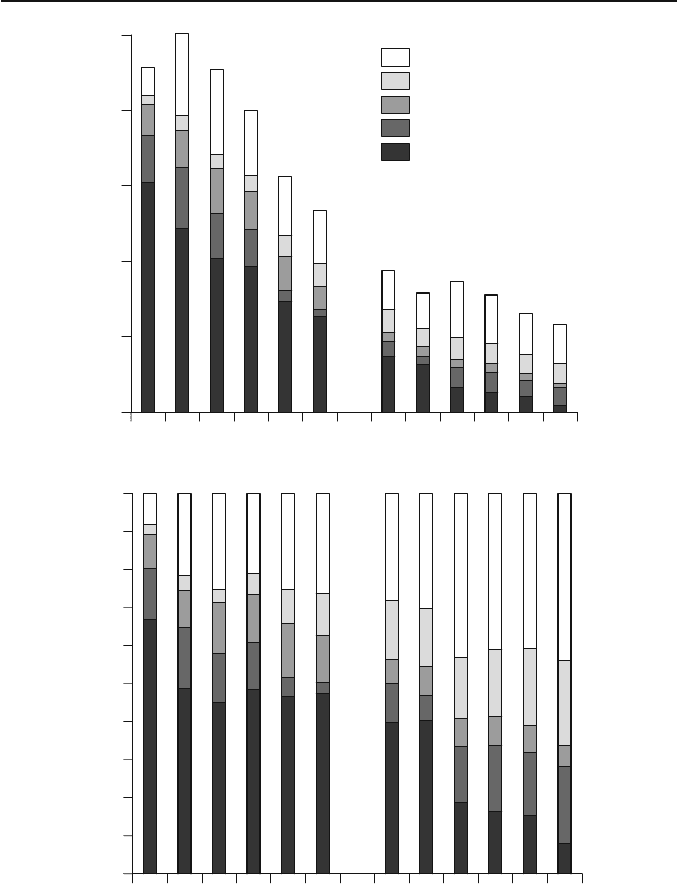
SCOTTISH GAELIC TODAY 591
Below national rate
National rate–24.9%
25–49.9%
50–69.9%
70%+
250,000
200,000
150,000
100,000
50,000
0
1881
1891
1901
1911
1921
1931
1941
1951
1961
1971
1981
1991
2001
1881
1891
1901
1911
1921
1931
1941
1951
1961
1971
1981
1991
2001
100%
90%
80%
70%
60%
50%
40%
30%
20%
10%
0%
Figure 13.1 Gaelic speakers by area of incidence 1881–2001 (a) numerical,
(b) percentages
(a)
(b)
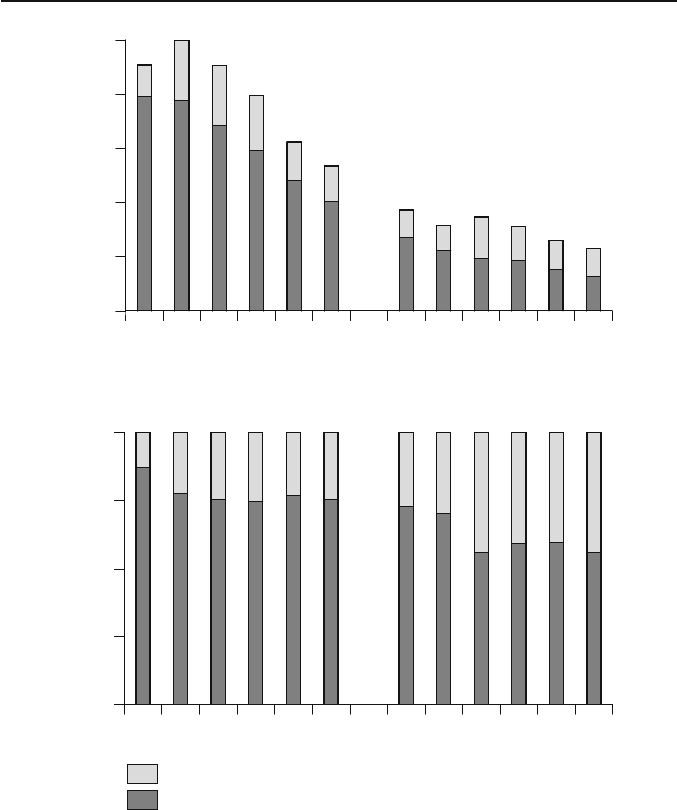
592 THE SOCIOLINGUISTICS OF THE CELTIC LANGUAGES
1881
1891
1901
1911
1921
1931
1941
1951
1961
1971
1981
1991
2001
250,000
200,000
150,000
100,000
50,000
0
Gaelic speakers in Lowlands/rest of Scotland
Gaelic speakers in Highland and Islands areas
1881
1891
1901
1911
1921
1931
1941
1951
1961
1971
1981
1991
2001
100%
75%
50%
25%
0%
Gaelic speakers in Lowlands/rest of Scotland
Gaelic speakers in Highland and Islands areas
Figure 13.2 Gaelic speakers in Highland and Lowland areas 1881–2001 (a) numerical,
(b) percentages. Source: GROS 1931 census, Table 54; 1961 Gaelic Report, Table 3;
1971 Gaelic Report, Table A; 1981 census LBS, p. 9, Table 40; 2001 Gaelic Report,
Tables 1 and 3
(b)
(a)
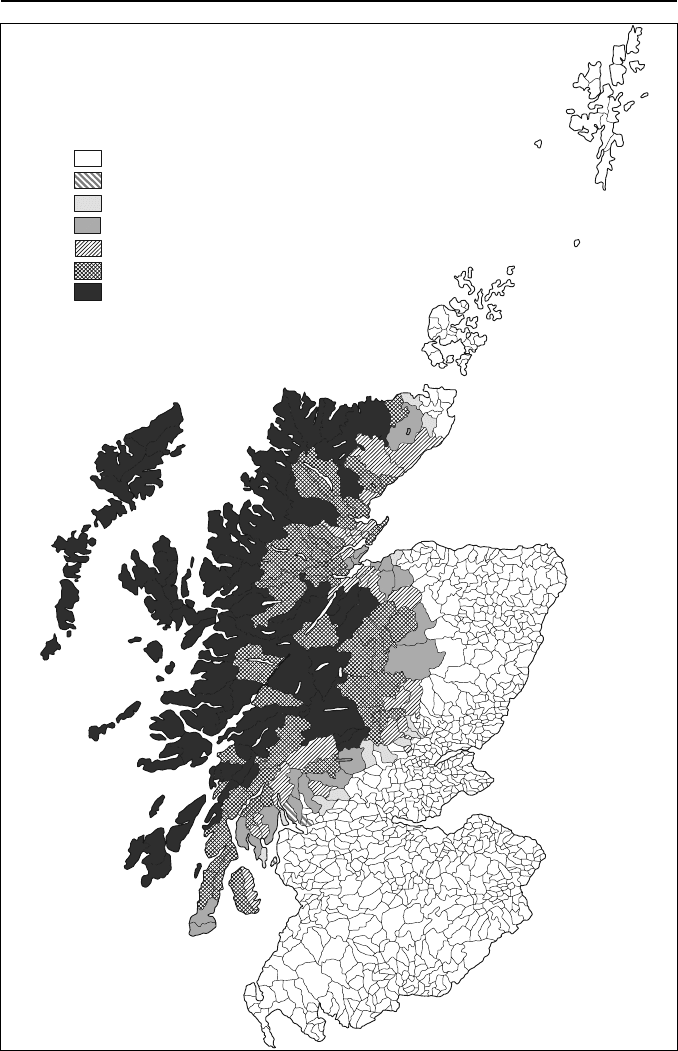
SCOTTISH GAELIC TODAY 593
Percentage ranges:
Not shown on this map
Less than 6.32
6.32 to less than 10
10 to less than 25
25 to less than 50
50 to less than 70.711
70.711 or more
Figure 13.3 1891 census: persons aged 3 and over able to speak Gaelic, as a percentage
of total population, by civil parish. Source: General Register Offi ce (Scotland) 2008
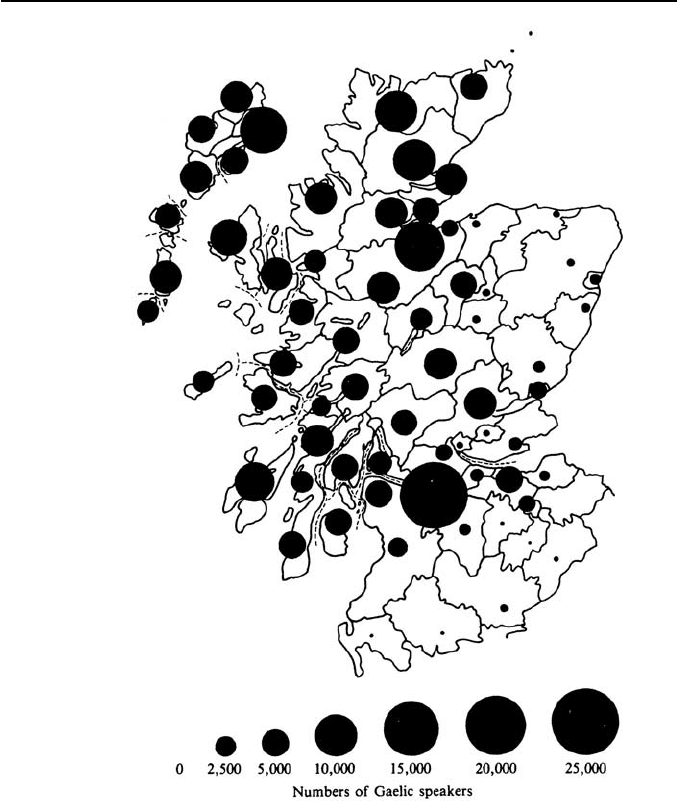
594 THE SOCIOLINGUISTICS OF THE CELTIC LANGUAGES
Figure 13.4 Size and location of Gaelic populations: 1891 census Scotland
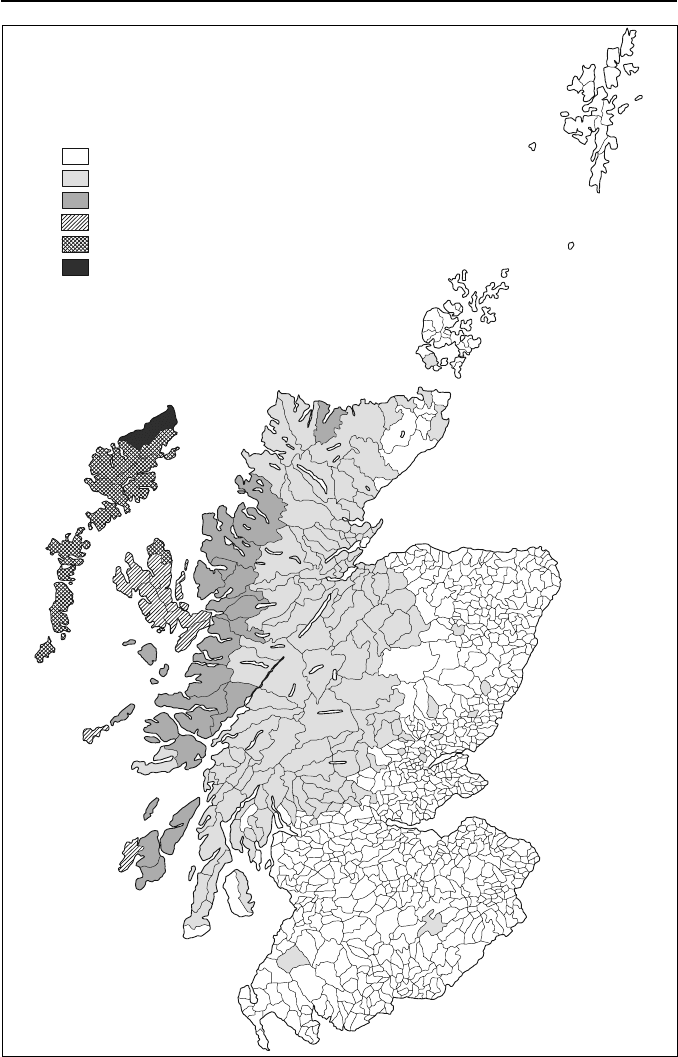
SCOTTISH GAELIC TODAY 595
Percentage ranges:
Less than 1.197
1.197 to less than 10
10 to less than 25
25 to less than 50
50 to less than 70.711
70.711 or more
Figure 13.5 Map 2001 census – parishes. Source: General Register Offi ce (Scotland) 2008
